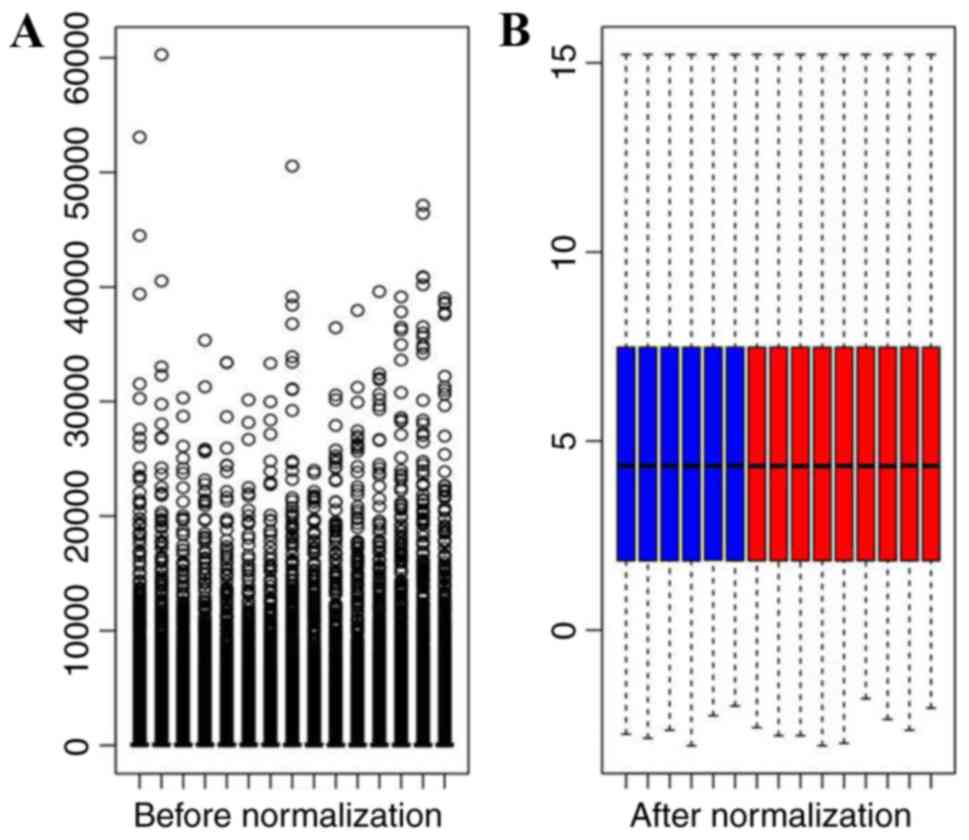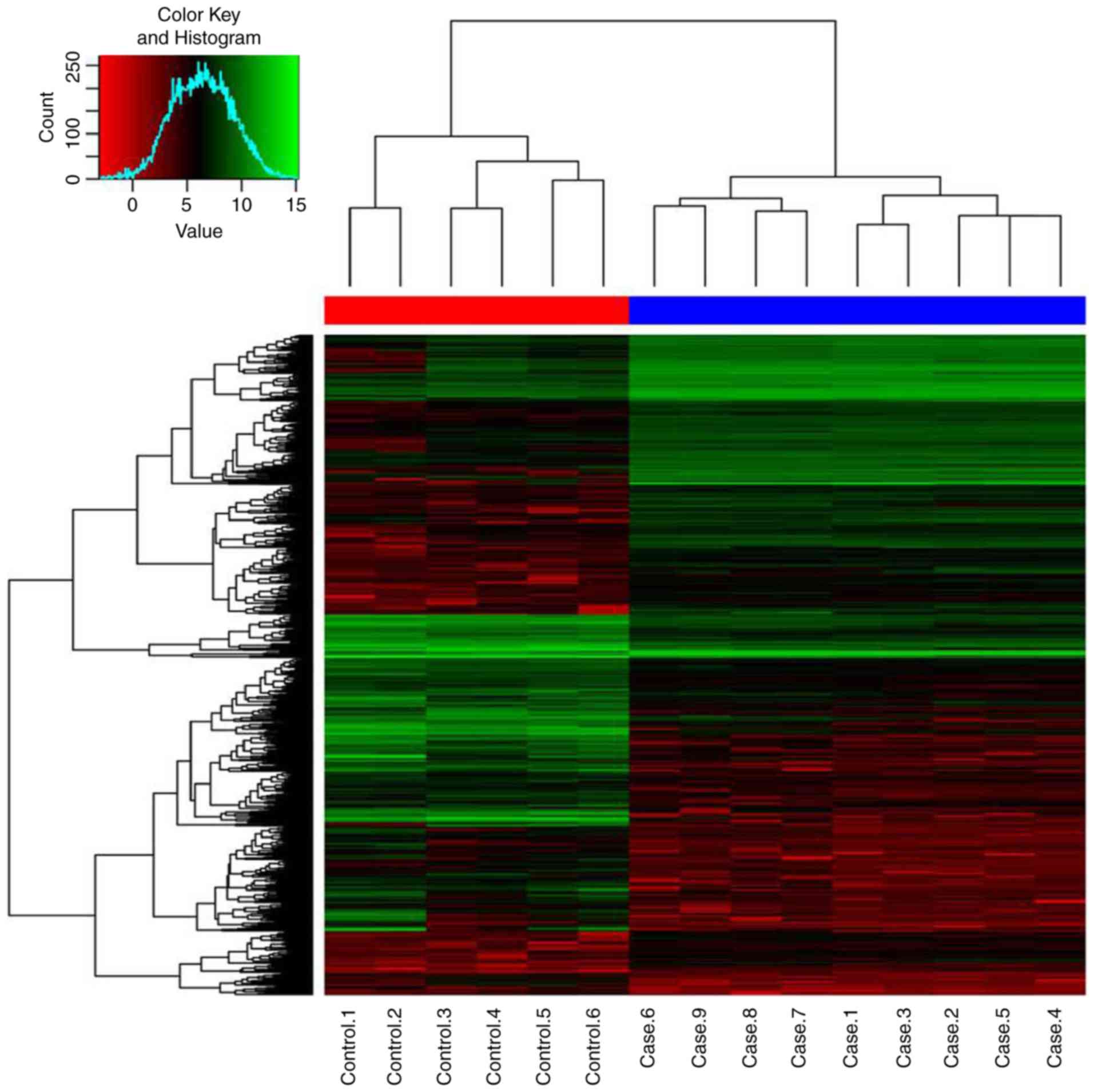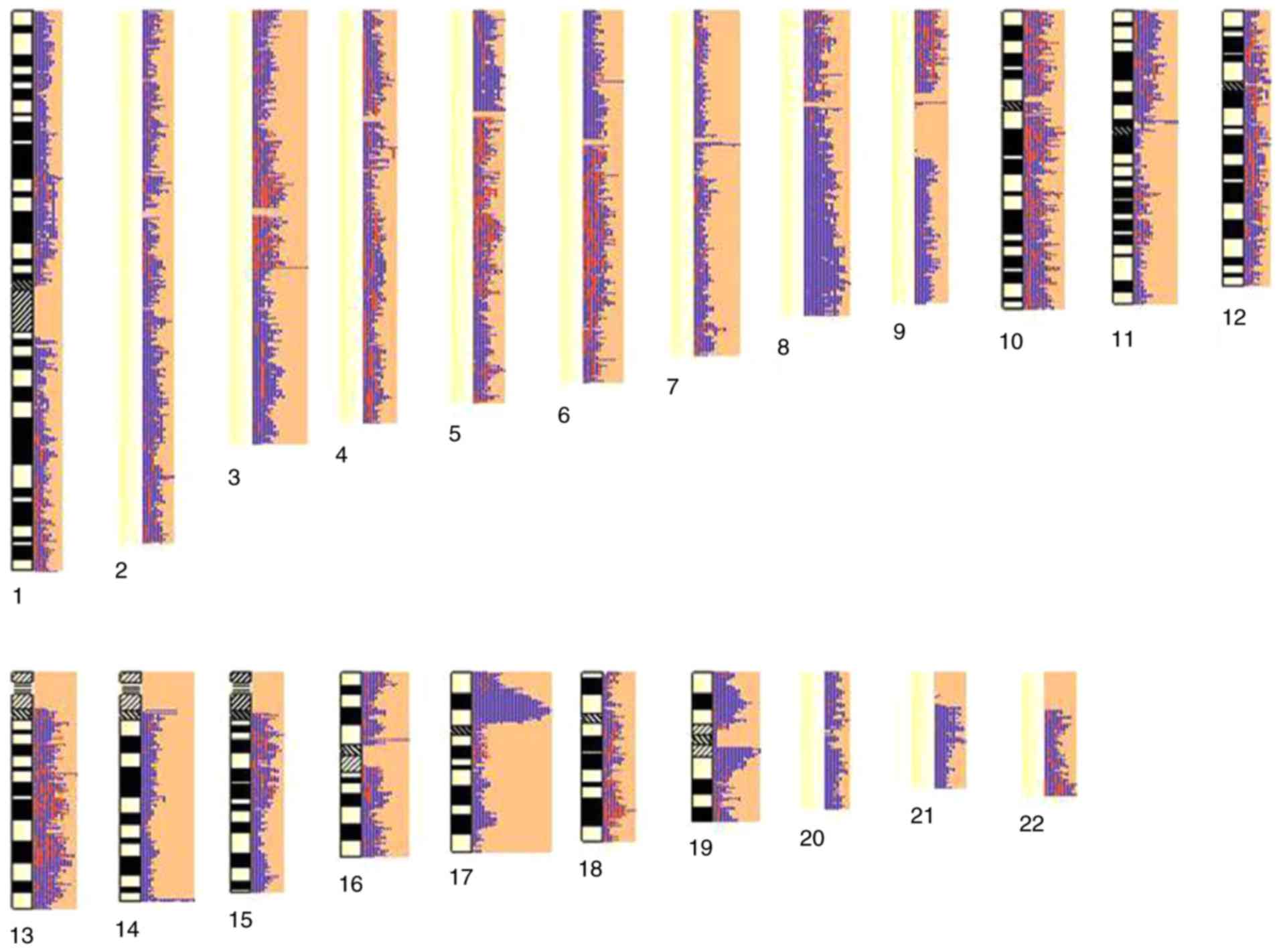|
1
|
Heymann D and Rédini F: Targeted therapies
for bone sarcomas. Bonekey Rep. 2:3782013. View Article : Google Scholar : PubMed/NCBI
|
|
2
|
Jemal A, Siegel R, Xu J and Ward E: Cancer
statistics, 2010. CA Cancer J Clin. 60:277–300. 2010. View Article : Google Scholar : PubMed/NCBI
|
|
3
|
Li C, Cheng Q, Liu J, Wang B, Chen D and
Liu Y: Potent growth-inhibitory effect of TRAIL therapy mediated by
double-regulated oncolytic adenovirus on osteosarcoma. Mol Cell
Biochem. 364:337–344. 2012. View Article : Google Scholar : PubMed/NCBI
|
|
4
|
He JP, Hao Y, Wang XL, Yang XJ, Shao JF,
Guo FJ and Feng JX: Review of the molecular pathogenesis of
osteosarcoma. Asian Pac J Cancer Prev. 15:5967–5976. 2014.
View Article : Google Scholar : PubMed/NCBI
|
|
5
|
Xiong Y, Wu S, Du Q, Wang A and Wang Z:
Integrated analysis of gene expression and genomic aberration data
in osteosarcoma (OS). Cancer Gene Ther. 22:524–529. 2015.
View Article : Google Scholar : PubMed/NCBI
|
|
6
|
Molyneux SD, Di Grappa MA, Beristain AG,
McKee TD, Wai DH, Paderova J, Kashyap M, Hu P, Maiuri T, Narala SR,
et al: Prkar1a is an osteosarcoma tumor suppressor that defines a
molecular subclass in mice. J Clin Invest. 120:3310–3325. 2010.
View Article : Google Scholar : PubMed/NCBI
|
|
7
|
Tang N, Song WX, Luo J, Haydon RC and He
TC: Osteosarcoma development and stem cell differentiation. Clin
Orthop Relat Res. 466:2114–2130. 2008. View Article : Google Scholar : PubMed/NCBI
|
|
8
|
Walkley CR, Qudsi R, Sankaran VG, Perry
JA, Gostissa M, Roth SI, Rodda SJ, Snay E, Dunning P, Fahey FH, et
al: Conditional mouse osteosarcoma, dependent on p53 loss and
potentiated by loss of Rb, mimics the human disease. Genes Dev.
22:1662–1676. 2008. View Article : Google Scholar : PubMed/NCBI
|
|
9
|
Kirov G, Rees E, Walters JT, Escott-Price
V, Georgieva L, Richards AL, Chambert KD, Davies G, Legge SE, Moran
JL, et al: The penetrance of copy number variations for
schizophrenia and developmental delay. Biol Psychiatry. 75:378–385.
2014. View Article : Google Scholar : PubMed/NCBI
|
|
10
|
Riccardi VM and Lupski JR: Duplications,
deletions, and single-nucleotide variations: The complexity of
genetic arithmetic. Genet Med. 15:172–173. 2013. View Article : Google Scholar : PubMed/NCBI
|
|
11
|
Porat RM, Pasic I, Shlien A, Golgoz N,
Andrulis I, Wunder JS and Malkin D: Genome-wide copy number
analysis reveals two novel loci for susceptibility to sporadic
osteosarcoma. Cancer Res. 71 8 Suppl:S53342011. View Article : Google Scholar
|
|
12
|
Luo Y, Deng Z and Chen J: Pivotal
regulatory network and genes in osteosarcoma. Arch Med Sci.
9:569–575. 2013. View Article : Google Scholar : PubMed/NCBI
|
|
13
|
MacEwen EG, Kutzke J, Carew J, Pastor J,
Schmidt JA, Tsan R, Thamm DH and Radinsky R: c-Met tyrosine kinase
receptor expression and function in human and canine osteosarcoma
cells. Clin Exp Metastasis. 20:421–430. 2003. View Article : Google Scholar : PubMed/NCBI
|
|
14
|
Ferracini R, Angelini P, Cagliero E,
Linari A, Martano M, Wunder J and Buracco P: MET oncogene aberrant
expression in canine osteosarcoma. J Orthop Res. 18:253–256. 2000.
View Article : Google Scholar : PubMed/NCBI
|
|
15
|
Coltella N, Manara MC, Cerisano V,
Trusolino L, Di Renzo MF, Scotlandi K and Ferracini R: Role of the
MET/HGF receptor in proliferation and invasive behavior of
osteosarcoma. FASEB J. 17:1162–1164. 2003.PubMed/NCBI
|
|
16
|
Naka T, Iwamoto Y, Shinohara N, Ushijima
M, Chuman H and Tsuneyoshi M: Expression of c-met proto-oncogene
product (c-MET) in benign and malignant bone tumors. Mod Pathol.
10:832–838. 1997.PubMed/NCBI
|
|
17
|
Dani N, Olivero M, Mareschi K, van Duist
MM, Miretti S, Cuvertino S, Patanè S, Calogero R, Ferracini R,
Scotlandi K, et al: The MET oncogene transforms human primary
bone-derived cells into osteosarcomas by targeting committed
osteo-progenitors. J Bone Miner Res. 27:1322–1334. 2012. View Article : Google Scholar : PubMed/NCBI
|
|
18
|
Huang DW, Sherman BT, Tan Q, Collins JR,
Alvord WG, Roayaei J, Stephens R, Baseler MW, Lane HC and Lempicki
RA: The DAVID gene functional classification tool: A novel
biological module-centric algorithm to functionally analyze large
gene lists. Genome Biol. 8:R1832007. View Article : Google Scholar : PubMed/NCBI
|
|
19
|
Kanehisa M and Goto S: KEGG: Kyoto
encyclopedia of genes and genomes. Nucleic Acids Res. 28:27–30.
2000. View Article : Google Scholar : PubMed/NCBI
|
|
20
|
Mohseny AB, Tieken C, van der Velden PA,
Szuhai K, de Andrea C, Hogendoorn PC and Cleton-Jansen AM: Small
deletions but not methylation underlie CDKN2A/p16 loss of
expression in conventional osteosarcoma. Genes Chromosomes Cancer.
49:1095–1103. 2010. View Article : Google Scholar : PubMed/NCBI
|
|
21
|
Lim JH, Chang YC, Park YB, Park JW and
Kwon TK: Transcriptional repression of E2F gene by proteasome
inhibitors in human osteosarcoma cells. Biochem Biophys Res Commun.
318:868–872. 2004. View Article : Google Scholar : PubMed/NCBI
|
|
22
|
Tsantoulis PK and Gorgoulis VG:
Involvement of E2F transcription factor family in cancer. Eur J
Cancer. 41:2403–2414. 2005. View Article : Google Scholar : PubMed/NCBI
|
|
23
|
Helt AM and Galloway DA: Mechanisms by
which DNA tumor virus oncoproteins target the Rb family of pocket
proteins. Carcinogenesis. 24:159–169. 2003. View Article : Google Scholar : PubMed/NCBI
|
|
24
|
Lees JA, Saito M, Vidal M, Valentine M,
Look T, Harlow E, Dyson N and Helin K: The retinoblastoma protein
binds to a family of E2F transcription factors. Mol Cell Biol.
13:7813–7825. 1993. View Article : Google Scholar : PubMed/NCBI
|
|
25
|
Nevins JR: The Rb/E2F pathway and cancer.
Hum Mol Genet. 10:699–703. 2001. View Article : Google Scholar : PubMed/NCBI
|
|
26
|
Baldin V, Lukas J, Marcote MJ, Pagano M
and Draetta G: Cyclin D1 is a nuclear protein required for cell
cycle progression in G1. Genes Dev. 7:812–821. 1993. View Article : Google Scholar : PubMed/NCBI
|
|
27
|
Gokgoz N, Wunder JS and Andrulis IL:
Genome-wide analysis of DNA copy number variations in osteosarcoma.
Cancer Res. 72 8 Suppl:S50752012. View Article : Google Scholar
|
|
28
|
Lynn M, Wang Y, Slater J, Shah N, Conroy
J, Ennis S, Morris T, Betts DR, Fletcher JA and O'Sullivan MJ:
High-resolution genome-wide copy-number analyses identify localized
copy-number alterations in Ewing sarcoma. Diagn Mol Pathol.
22:76–84. 2013. View Article : Google Scholar : PubMed/NCBI
|
|
29
|
Ottaviano L, Schaefer KL, Gajewski M,
Huckenbeck W, Baldus S, Rogel U, Mackintosh C, de Alava E,
Myklebost O, Kresse SH, et al: Molecular characterization of
commonly used cell lines for bone tumor research: A trans-European
EuroBoNet effort. Genes Chromosomes Cancer. 49:40–51. 2010.
View Article : Google Scholar : PubMed/NCBI
|
|
30
|
Liu YZ, Pei YF, Liu JF, Yang F, Guo Y,
Zhang L, Liu XG, Yan H, Wang L, Zhang YP, et al: Powerful bivariate
genome-wide association analyses suggest the SOX6 gene influencing
both obesity and osteoporosis phenotypes in males. PLoS One.
4:e68272009. View Article : Google Scholar : PubMed/NCBI
|
|
31
|
Freeman SS, Allen SW, Ganti R, Wu J, Ma J,
Su X, Neale G, Dome JS, Daw NC and Khoury JD: Copy number gains in
EGFR and copy number losses in PTEN are common events in
osteosarcoma tumors. Cancer. 113:1453–1461. 2008. View Article : Google Scholar : PubMed/NCBI
|
|
32
|
Berx G and Van Roy F: Involvement of
members of the cadherin superfamily in cancer. Cold Spring Harb
Perspect Biol. 1:a0031292009. View Article : Google Scholar : PubMed/NCBI
|
|
33
|
Goss KH and Groden J: Biology of the
adenomatous polyposis coli tumor suppressor. J Clin Oncol.
18:1967–1979. 2000. View Article : Google Scholar : PubMed/NCBI
|
|
34
|
Yagi T and Takeichi M: Cadherin
superfamily genes: Functions, genomic organization, and neurologic
diversity. Genes Dev. 14:1169–1180. 2000.PubMed/NCBI
|
|
35
|
Venkatachalam R, Verwiel ET, Kamping EJ,
Hoenselaar E, Görgens H, Schackert HK, Van Krieken JH, Ligtenberg
MJ, Hoogerbrugge N, van Kessel AG and Kuiper RP: Identification of
candidate predisposing copy number variants in familial and
early-onset colorectal cancer patients. Int J Cancer.
129:1635–1642. 2011. View Article : Google Scholar : PubMed/NCBI
|
|
36
|
Dziadek M: Role of laminin-nidogen
complexes in basement membrane formation during embryonic
development. Experientia. 51:901–913. 1995. View Article : Google Scholar : PubMed/NCBI
|
|
37
|
Kleinman HK, Cannon FB, Laurie GW, Hassell
JR, Aumailley M, Terranova VP, Martin GR and DuBois-Dalcq M:
Biological activities of laminin. J Cell Biochem. 27:317–325. 1985.
View Article : Google Scholar : PubMed/NCBI
|
|
38
|
Li X, Kong X, Huo Q, Guo H, Yan S, Yuan C,
Moran MS, Shao C and Yang Q: Metadherin enhances the invasiveness
of breast cancer cells by inducing epithelial to mesenchymal
transition. Cancer Sci. 102:1151–1157. 2011. View Article : Google Scholar : PubMed/NCBI
|
|
39
|
Zhu K, Dai Z, Pan Q, Wang Z, Yang GH, Yu
L, Ding ZB, Shi GM, Ke AW, Yang XR, et al: Metadherin promotes
hepatocellular carcinoma metastasis through induction of
epithelial-mesenchymal transition. Clin Cancer Res. 17:7294–7302.
2011. View Article : Google Scholar : PubMed/NCBI
|
|
40
|
Wei Y, Hu G and Kang Y: Metadherin as a
link between metastasis and chemoresistance. Cell Cycle.
8:2132–2137. 2009. View Article : Google Scholar : PubMed/NCBI
|
|
41
|
Zhu L, Zhang P, Yang Y, Buford AS, Wang
WL, Thomas DG and Hughes DP: Abstract A53: Metadherin functions as
a laminin receptor that is essential for metastasis and is
associated with poor survival in osteosarcoma. Cancer Res. 74 20
Suppl:A532014. View Article : Google Scholar
|












